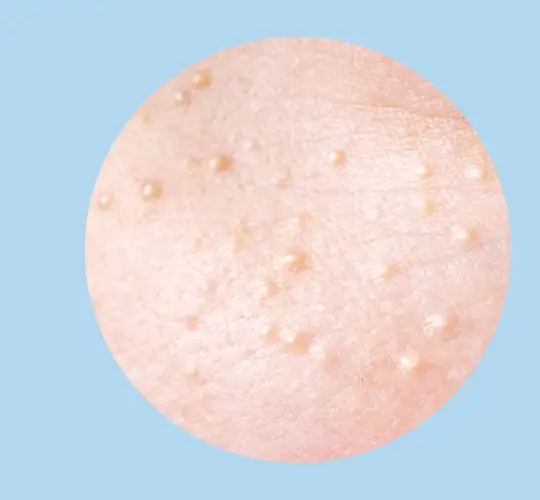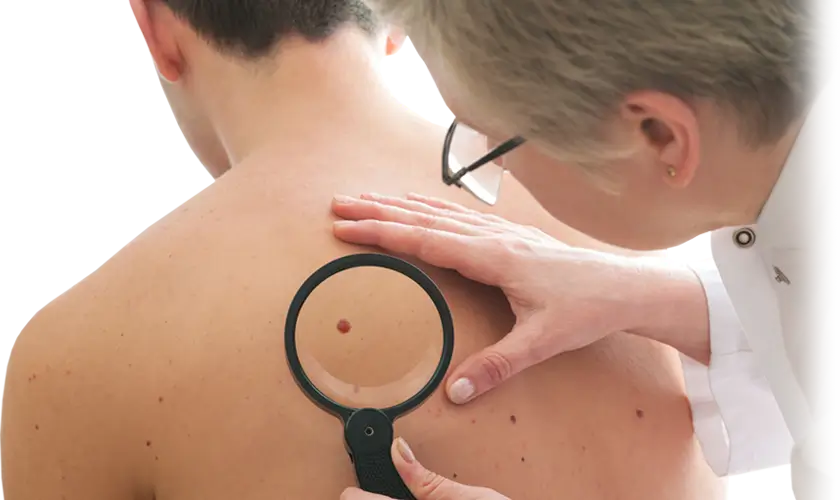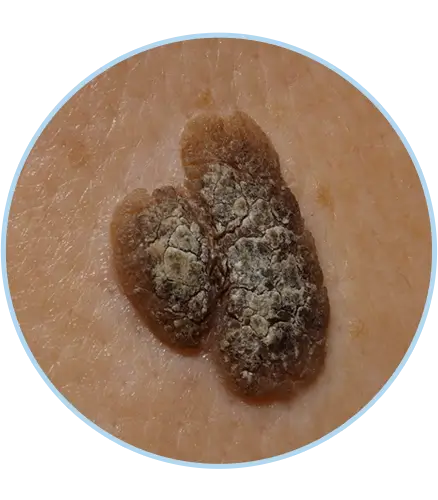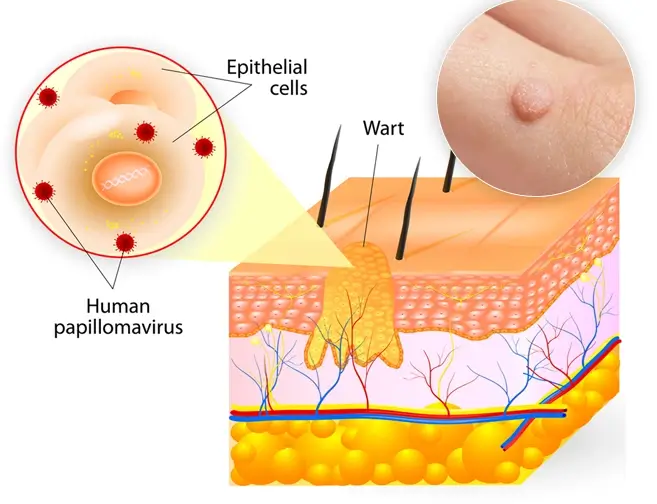Skin Tag
Skin Tag Removal

Remove Skin Tags In Minutes
Feel More Confident About Yourself
Quick & Easy Procedure
What Are Skin Tags?
Although genetics may play a role, the precise reason for skin tags has yet to be determined. The most popular explanation is that skin friction against itself, or the rubbing of two surfaces, causes skin tags to develop. One study showed that HPV was present in many people with skin tags, which points to the virus as a factor.
What Do Skin Tags Look Like?
Skin tags are benign growths that resemble a tiny, soft balloon hanging from a delicate stalk on the skin. They might be smooth or irregular in form, and they frequently have thread-like extensions at their base that might be mistaken for tiny hairs. They can vary in colour but are usually brown or black.
Where Do Skin Tags Appear?
They can appear anywhere on the body, but the most common areas are:
- Eyelids
- Under breast
- Upper chest
- Underarms
- Groin
- Neck
They’re commonly overlooked unless they’re in a prominent location or are repeatedly rubbed or scraped, for example, by clothing, jewellery, or shaving.
How To Remove Skin Tags?
There are many ways you can get rid of skin tags, and they are typically harmless, but you may want them gone if they interfere with your social life or self-esteem. The method we use is Advanced Electrolysis.
What Is Advanced Electrolysis Procedure?
Advanced electrolysis is a highly effective method for removing skin tags that have been in use since 1875. It takes a few minutes to permanently remove these small benign growths from your body, with patients typically enjoying 100% success rates and no post-procedure complications.
A thermolysis current is sent through a tiny needle that cauterizes the tag during this technique. This allows for the electrolysis technique to be effective in eradicating skin tags. This quick process generally takes five to ten minutes and causes minimum discomfort.
The process usually only takes 15-30 minutes to complete, depending upon the size of the tag being treated. Large tags will be removed on the same day as treatment, but smaller ones can fall off within a few days following this procedure.
Milia Removal

Remove Unsightly White Spots
Clearer Complexion
Quick & Easy Procedure
Get Rid of Milia for Good
Milia, commonly known as milk spots or harden whiteheads, are small white bumps /pimples that appear on people’s faces. While they’re a common skin condition and typically harmless, it can be frustrating to have them around the eyes or lips where makeup isn’t normally worn.
Milia are commonly found in newborns but may also develop in adults if their skin has been irritated by sunburn and harsh chemicals. The good news is that there are several ways to remove milia for good without going through extensive medical procedures.
What Causes Milia?
Milia is caused by the build-up of keratin which is the protein that makes up your nails, hair, and skin. Milia forms when dead cells don’t shed as they should on the skin, becoming trapped beneath the new skin and hardening to develop milia.
Milia can also sometimes happen when skin is irritated by sunburn, cosmetic products that are thick or very oil-based, or harsh chemicals.
How To Get Rid Of Milia?
There are many ways to get rid of milia depending on the severity. Mila is typically harmless, but you may want them gone if they interfere with your social life or self-esteem.
The most frequent method of Milia Removal we use is advanced electrolysis.
What Is Advanced Electrolysis Procedure?
Advanced electrolysis is one of the most effective treatments available for permanent milia removal. The procedure is virtually pain-free, and often clients describe it feels like pinpricks.
We use a fine probe to send a current into the milia. This current breaks down the fatty tissue (or keratin build-up) to be reabsorbed into the skin.
The clinician will leave the treated milia, which will naturally disappear over a few days but can take up to 14 days; however, if the milia are ready for extraction, this can be done straight away.
Skin Blemishes

Non Invasive Treatment
Results Can Be Instantaneous
Qualified Staff
Common Skin Blemishes: How To Identify & Treat Them - In One Easy Treatment.
Blemishes on your skin can be both unsightly and embarrassing. Many different things can cause them, and they come in all shapes and sizes.
We’ll explore some of the most common skin blemishes that people experience, and we’ll discuss how to identify them as well as potential treatment options that we offer.
What Are Skin Blemishes and What Causes Them?
Skin blemishes can result from many things:- lifestyle habits, ageing, sun exposure, and causes of skin infection via the human papillomavirus (HPV). The most common skin blemishes that people experience are skin tags, age spots, moles and blood spots.
When Should I Worry About Skin Blemishes?
If you have skin blemishes changing in size, shape, or colour, you should visit a skin specialist as soon as possible. Our skin specialists are trained to detect skin disorders by skin type and skin blemish.
What Are Examples Of Skin Blemishes:
- Milia: are small white hard pimples or cysts that form around the skin’s pores.
- Skin tags: are small, soft growths on the skin that look like warts. They often vary in size and colour.
- Spider veins & Thread veins: are small clusters of thin red blood vessels that appear around the skin’s surface.
- Age spots (lentigines): are small, flat dark areas of the skin and can happen anywhere on the body.
- Blood spots (Campbell De Morgan): are harmless red spots that result from proliferating, dilated capillaries and postcapillary venules.
- Dermatosis Papulosa Nigra: are dark or skin-coloured bumps on the face, neck, and upper torso. Some people have a few spots, while others are affected by many of them over large areas of their skin.
- Seborrhoeic Keratosis (Wart): are generally brown, black, or light tan. The growths appear waxy, scaly and raised. They usually appear on the head, neck, chest, or back.
- Plane and Common Warts: are tiny, flat-topped skin-coloured papules that generally appear on the face, hands, and shins.
- Verrucas: are warts that grow on the soles of your feet. They might have tiny black dots in the middle.
- Sebaceous Cyst: These are small, benign lumps that develop beneath the skin’s surface. They generally appear on the head, face, ears, trunk, or back.
- Moles: are tiny, coloured patches on the skin. They can be flat, raised, oval, or round and sometimes have hair growing out of them. Most people have them, and they’re usually nothing to worry about unless they grow in size, form, or colour.
What Treatment Does we Offer For Skin Blemish Removal?
We use the Advance Electrolysis technique for skin blemish removal. Electrolysis has been used to treat such issues as broken capillaries, spider naevi, and warts for more than a century. The continual improvement of cutting-edge technology has advanced considerably and is a straightforward and safe procedure.
How Does It Work?
Electrolysis is a non-surgical and non-invasive treatment procedure that uses a Thermolysis or Blend current alongside a very fine, tiny needle that cauterizes or lifts away from the blemish.
Seborrhoeic Keratosis Wart Removal

Quick & Easy Procedure
Feel Confident About Yourself
Carried Out By Qualified Staff
What Is Seborrhoeic Keratosis Wart?
Seborrhoeic Keratosis, also known as seborrhoeic warts, is a blemish that can be found on the skin. It is a benign growth on your skin and can often be mistaken for a wart, but it is a type of seborrhoeic keratosis. The epidermis is the outer layer of your skin. Keratinocytes are the cells that make up most of this layer. These cells frequently flake off as new cells replace them.
Keratinocytes may grow in more significant numbers than usual from time to time. This might result in keratosis (a condition characterised by benign, cauliflower-like lumps on the skin). This is a more advanced form of keratosis. It’s most prevalent in people over the age of 50. Although it is usually harmless, it is quite common, and individuals dislike its appearance. Benign growths on the skin are generally only aesthetic concerns. They can irritate the skin in some people if they’re placed against clothing.
What Does Seborrhoeic Keratosis Look Like?
Seborrhoeic Keratosis appears waxy or soggy in appearance. They can be brown, pink, or skin-coloured and are often wet-looking. Small blood vessels may be seen near the top of these lesions. They can appear on any part of the body, although they are most common on the trunk, head, neck and face.
What Treatment Does We Offer For Seborrhoeic Keratosis?
Advanced electrolysis is a highly effective method for getting rid of seborrhoeic keratosis. It takes a few minutes to treat the keratosis permanently, and from our experience, patients typically enjoy 100% success rates.
Your clinician will treat the blemish with electrolysis and remove it entirely during the treatment. The process usually only takes 30-45 minutes to complete. After treatment, a small scab will form, slough off naturally in a few days.
Common Wart Removal

Advance Electrolysis
Minimal Downtime
Qualified Staff Complete Treatments
What Are Common Warts?
Common warts are tiny, gritty skin growths that typically appear on your fingers or hands. Common warts are rough to the touch and usually have a network of tiny black dots, small clotted blood vessels.
The human papillomavirus (HPV) is the most common cause of warts. The virus has more than 150 types, but only a few of them lead to wartlike formations on your hands. The virus typically spreads via breaks in your skin, such as cuts and scrapes. Regularly biting your nails could also spread warts from one finger to another.
What Do Common Warts Look Like?
Common warts appear as small pink or flesh-coloured growths with an irregular shape with dark spots inside and can be rough to touch. Commonly seen on hands or fingers.

What Treatment Does We Offer For Common Warts?
Advanced electrolysis is a highly effective method for getting rid of common warts. It takes a few minutes to treat the wart permanently, and from our experience, patients typically enjoy 100% success rates.
Your clinician will treat the wart with electrolysis and remove it entirely during the treatment if it is soft. The wart will be treated and left to slough off naturally in 14 days if it is hard.
The process usually only takes 15-45 minutes to complete, depending upon the number of common warts being treated.
Plane Warts Removal

A Safe & Effective Way To Get Rid Of Warts
No Need For Surgery
Clearer Skin
What Are Plane Warts?
Plane warts are a form of wart caused by the human papillomavirus. They occur when the virus infects the skin and causes the skin cells to grow abnormally. Plane warts are typically found on the face, hands or feet but can occur anywhere on the body. They are often flat and smooth. Plane warts are not considered dangerous and pose a severe health risk.
What Do Plane Warts Look Like?
Plane warts are typically a collection of small flat-topped skin-coloured papules that seem to grow in clusters and are common on the face/ back of hands. The virus is often transmitted via shaving, resulting in many warts on the shins and beard region and often feel rough to touch.
What Treatment Does We Offer For Plane Warts?
Advanced electrolysis is a highly effective method for getting rid of Plane warts. It takes a few minutes to treat the wart permanently, and from our experience, patients typically enjoy 100% success rates.
Your clinician will treat the wart with electrolysis and remove the wart fully during the treatment. The process usually only takes 15-45 minutes to complete, depending upon the number of plane warts being treated. After treatment, a small scab will form, slough off naturally in a few days.
Blood Spots Removal

Carried Out By Qualified Staff
Feel More Confident About Yourself
A Virtually Painless Process
Blood Spot Removal Known as Campbell De Morgan or Cherry Angioma
Blood Spots or Cherry Angioma spots are otherwise called Campbell De Morgan spots. This is a common skin condition that usually appears on any body part.
The treatment for blood spot removal is Advanced Electrolysis Treatment using Thermolysis to permanently remove them from your skin. We will discover the causes and treatments for Blood Spots so you can know what to do if you have these tiny red dots on your face or neck!
What Are Blood Spots?
Campbell de Morgan spots look like blood spots and are a frequent type of skin growth that can affect almost any part of your body. They’re also known as cherry angiomas or Senile angiomas.
Campbell de Morgan spots are caused by the expansion of dilated capillaries and postcapillary venules and the accumulation of tiny blood vessels within a cherry angioma, which gives them a reddish appearance.
However, Campbell de Morgan spots can be blue or purple, generally non-blanching. They might vary in size and form.
What Causes Blood Spots?

- Sun exposure and photodamage
- Age (most common cause)
- Rosacea or other skin inflammation conditions
- Groin
How To Remove Blood Spots?
Advanced electrolysis can treat Campbell de Morgan spots in one easy and fast procedure. The feeding vessel to the angiomas is cauterized with the current, which promptly removes tiny angiomas. After the treatment, very small angioma disappear or may turn a darker grey colour and naturally disappear in two weeks.
Larger/raised angiomas may crust or form a small scab and, in rare cases, require a second treatment to eliminate.
Mole Removal

Quick, Painless Advanced Treatment
Best Results With Thoroughly Trained Staff
Boost Your Self-Confidence
What Is A Skin Mole
Moles are a common skin condition that affects many people. They can appear anywhere on the body but most commonly occur on the face and neck. Moles can range in colour from pink to light brown, dark brown or even black.
Moles typically appear during childhood and adolescence, although most people have 10 to 40 moles, some of which may alter in appearance or fade with time. They are usually round or oval but can be very small or large, flat or raised, smooth or bumpy, and may or may not have hair growing out of them.
The majority of moles are harmless, but there is always the risk of cancer. That’s why it’s crucial to have your moles checked regularly by a dermatologist.
What Causes Skin Moles?
Moles are formed when melanocytes in the skin’s cells (melanocytes) grow in clusters or clumps. Melanin, the natural pigment that gives your skin its colour, is produced by melanocytes distributed throughout your skin.
What Do Healthy Moles Look Like?
The majority of moles are brown. Moles come in a variety of shapes, forms, and sizes:
Texture and Colour: Moles are tiny, soft, and round. Brownish-grey to tan colour may be smooth or wrinkled, flat or raised. The moles might have hair growing from them.
Shape: Moles are usually round or oval
Size: Moles are generally tiny, about 6 millimetres or less in diameter — roughly the size of a pencil eraser. Moles can occasionally be much larger at birth (congenital nevi).
Can I Remove Or Reduce A Mole For Cosmetic Reason?
The majority of moles are harmless, but there is always the risk of it being cancerous. That’s why it’s essential to have your moles checked regularly by a dermatologist. Moles can usually be removed for cosmetic reasons with electrolysis.
Most patients choose electrolysis because it is less expensive and less painful than surgery or laser therapy. We remove moles using advanced electrolysis.
About Our Skin Mole Removal Services
We uses the procedure of advanced electrolysis to remove moles by sending an electrical current into a mole and destroying its cells without damaging any surrounding tissue. Usually, the mole is left to slough off naturally but can also be removed on the same day. This method has been proven quick, painless, effective and leaves little scarring at the treatment site.
